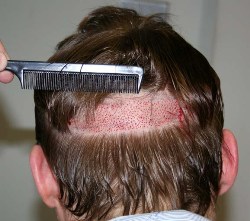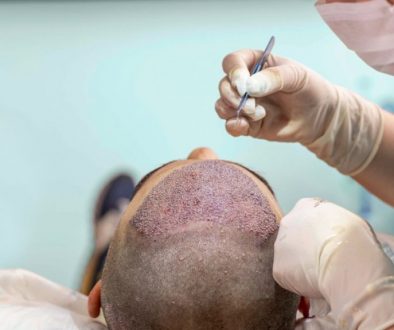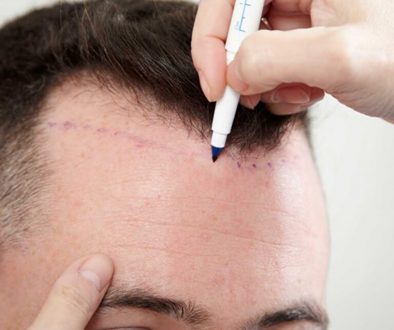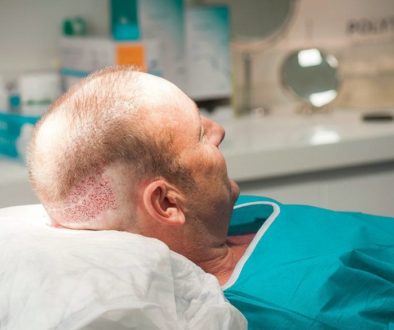What Kind of Growth Rate can I Expect from a Follicular Unit Extraction (FUE) Hair Restoration Procedure?
This question comes from a member of our [tag]Hair Restoration[/tag] Social Community and Discussion Forums:
I’m looking to undergo a moderately sized [tag]follicular unit extraction[/tag] ([tag]FUE[/tag]) procedure, but I’m having trouble finding information on the actual growth rate/yield I can expect from FUE. What kind of growth rate can I expect from a follicular unit extraction (FUE) procedure?
 I think there are two things to consider with regard to follicular unit extraction (FUE) and yield/growth rate: 1. any damage to [tag]follicular unit graft[/tag]s during the extraction phase (which would damage the follicle and result in a graft that didn’t grow) and 2. a graft extracted from outside the universal extraction zone, which would be susceptible to future hair loss (as the graft wouldn’t be as resistant to [tag]dihydrotestosterone[/tag] – [tag]DHT[/tag]).
I think there are two things to consider with regard to follicular unit extraction (FUE) and yield/growth rate: 1. any damage to [tag]follicular unit graft[/tag]s during the extraction phase (which would damage the follicle and result in a graft that didn’t grow) and 2. a graft extracted from outside the universal extraction zone, which would be susceptible to future hair loss (as the graft wouldn’t be as resistant to [tag]dihydrotestosterone[/tag] – [tag]DHT[/tag]).
The first variable is dependent on the skill of the [tag]hair restoration surgeon[/tag] and, to a much lesser extent, the tool used. If you visit an experienced FUE surgeon, my guess is that the ’90 – 95%’ number often quoted (which is comparable to the 95% growth rate experienced with traditional [tag]follicular unit transplantation[/tag]) would be accurate. If the practitioner has less experience with extracting follicular units, than issues with transection become apparent and the ‘yield rate’ will suffer as a result.
The second variable is really up to the [tag]hair transplant surgeon[/tag], how many grafts he/she is trying to extract, and whether or not they feel like the follicles in these extraction areas (outside of the universal safe zone) are susceptible to future loss or not.
Some hair transplant surgeons seem to think that analyzing familial balding patterns and the patient’s current situation provide a good indication of whether these grafts should be utilized or not. Think about it this way – if the hair transplant surgeon is certain the patient won’t progress past a Norwood V, for example, than he/she would probably feel comfortable removing grafts from zones that would normally be affected by loss in a Norwood VI – VII patient.
Personally, I think this is a bit of a gamble, and something that can affect the actual yield rate for FUE procedures. If the surgeon is wrong and these grafts aren’t as resistant to DHT as assumed, then they could shed (eventually) and affect the yield/result as a whole.
If you select a talented, ethical hair transplant surgeon for your FUE procedure, my guess is that a modestly sized session could yield around 90 -95% growth.
_______________
Blake – aka Future_HT_Doc
Editorial Assistant and Forum Co-Moderator for the Hair Transplant Network, the Hair Loss Learning Center, the Hair Loss Q&A Blog, and the Hair Restoration Forum
Follow our community on Twitter
Watch hair transplant videos on YouTube
Get Proven Hair Loss Treatments at the Best Prices by visiting our new Online Hair Loss Product Store




October 4, 2013 @ 11:17 am
I don’t think it’s wise to to “guess” about regrowth rates. I’ve heard from doctors performing the procedure that 70-to 80% is more accurate. The fact is, there are no detailed studies to show what is possible in terms of regrowth with FUE. Dr. David Seagar did a number of detailed studies in the 90’s showing that the strip method can cinsistently yield 100% regrowth if done correctly. The key is what he called “chubby grafts”. Grafts with a lot of fatty tissue around them survive better. And in strip method microscopic dissection, you can see the every part of the graft, as well as the dormant follicles and follicle returning to anagen that have not surfaced yet. This helps to avoid any transection and allows precise control the amount of tissue around the graft. With FUE, regardless of the skill of the doctor, the follicle cannot be seen below the surface of the skin, so there is no way to know if the follicle is being transected, or of there are dormant or young hairs until the graft is already harvested. Also, there is no way to know how deep the graft goes below the surface of the skin. And depth really varies from graft to graft. Another big drawback is it is impossible to get a “chubby graft” with FUE, or at least I have never seen a picture anywhere of an FUE chubby graft. Pictures of FUE grafts show grafts that have a lot of tissue ripped off of them. This is because there is no way to cut the bottom of the graft cleanly: It has to be ripped out of the scalp.